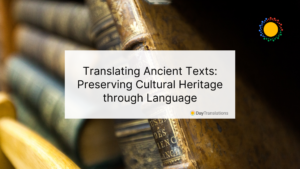Scientific discoveries shape the world we live in, from groundbreaking medical treatments to innovations in technology. But what happens when these discoveries need to cross language barriers? Enter the fascinating world of translating complex scientific texts—a process that requires precision, creativity, and a deep understanding of both language and science. Let’s explore how it all comes together and what goes into the process of translating scientific texts.
Why Translating Scientific Texts is Important
Science knows no borders. Researchers from different countries collaborate on projects, and their findings need to be understood worldwide. Translating scientific texts ensures that discoveries are accessible to everyone, from a Japanese researcher working on a new vaccine to a German engineer designing renewable energy solutions.
Without accurate translations, critical information could be lost or misunderstood. This can lead to delays in scientific progress or even costly mistakes. Translators bridge the gap, ensuring the message is clear and accurate in any language.
Step 1: Understanding the Subject Matter
Knowledge is Power
Before diving into the translation process, translators must familiarize themselves with the subject matter. Whether it’s a paper on quantum physics or a study about marine biology, understanding the content is crucial. This often means researching unfamiliar concepts, reading background materials, and sometimes consulting experts in the field.
A translator working on a scientific text is not just a language expert but also a detective. They must figure out what the original author is trying to convey and ensure they fully grasp the meaning before putting it into another language.
Step 2: Mastering the Terminology
The Language of Science
Science has its own language. Terms like “photosynthesis,” “fusion,” or “hypothesis” may not have direct equivalents in other languages, or their usage may differ slightly. This is where glossaries and terminology databases come in handy. Translators create or use these resources to ensure consistent and accurate use of technical terms.
Imagine translating a paper about DNA replication. Misinterpreting a single term could change the entire meaning of the text. This step requires meticulous attention to detail and a commitment to precision.
Step 3: Navigating Cultural Differences
More Than Just Words
Scientific texts are often written in a formal and structured style. However, different cultures have varying expectations for how information is presented. For example, English-language papers often follow a straightforward, concise format, while other languages might prefer more elaborate explanations.
Translators must adapt the text to fit the target audience’s expectations while maintaining the original meaning. This balancing act ensures that the translated text is not only accurate but also culturally appropriate and easy to read.
Step 4: Balancing Accuracy and Clarity
Simplifying Without Losing Meaning
Scientific texts can be dense and full of jargon. While accuracy is paramount, clarity is equally important. Translators often need to simplify complex concepts without losing their essence. This involves breaking down long, complicated sentences into more manageable parts and using simpler language where possible.
For instance, a sentence like “The compound’s reactivity was assessed through a series of controlled laboratory experiments designed to mimic real-world conditions” might be translated into something like “Scientists tested the compound’s reactivity in the lab to see how it would behave in real life.”
Step 5: Collaborating with Experts
Teamwork Makes the Dream Work
No translator works in isolation, especially when dealing with complex scientific texts. Collaboration with subject-matter experts is often essential. These experts can clarify confusing points, verify the accuracy of technical terms, and ensure the translation aligns with current scientific understanding.
This teamwork ensures that the final product is not only linguistically accurate but also scientifically valid.
Step 6: Final Review and Quality Assurance
Polishing the Final Product
Once the translation is complete, it’s time for a thorough review. This step involves proofreading for grammar and spelling errors, checking terminology consistency, and ensuring the text flows smoothly. Many translation agencies also use quality assurance tools to catch any missed errors.
Additionally, the final text may undergo a peer review process where other experts in the field evaluate its accuracy. This step ensures the translation is of the highest quality before it’s published or shared.
Challenges and Rewards of Translating Scientific Texts
Overcoming the Hurdles
Translating scientific texts isn’t without its challenges. Translators often face tight deadlines, highly technical content, and the pressure to get everything just right. Despite these hurdles, the work is incredibly rewarding.
By translating complex scientific texts, translators play a crucial role in advancing knowledge and fostering global collaboration. Their work makes it possible for groundbreaking discoveries to reach and benefit people around the world.
Conclusion: The Art and Science of Translating Scientific Texts
Translating complex scientific texts is both an art and a science. It requires linguistic skill, scientific knowledge, and a dedication to accuracy and clarity. From understanding the subject matter to collaborating with experts, each step in the process is vital to creating a translation that is both faithful to the original and accessible to the target audience.
Next time you read about a groundbreaking discovery from another country, take a moment to appreciate the hard work of the translators who made it possible. Their efforts ensure that science continues to break barriers and unite us all.












Sorry, the comment form is closed at this time.